|
Navigation LakesnWoods.com
Home
Page
Contact Us
Privacy
Minnesota History Shop
Visit The Minnesota History Shop
www.minnesotahistoryshop.com
Historic maps
Historic books
Historic framed art
Historic
postcards
Clothing with historic
images
And much more!!! |
Hammond Guide:
Photo Gallery
Location
Geography
Demographics
History
Government
Post Office
News
Weather
Street Map
Events
Attractions
Recreation
Lakes
Health Care
Schools
Churches
Media
Motels
Resorts
Campgrounds
Businesses
Aerial Photo
Topographic
Map © 2004-2025
LakesnWoods LLC
All Rights Reserved
DCMA, Defamation, Copyright and Trademark Infingement Policy
|
WANTED! Do you have photos, historical accounts or other
items pertaining to the Hammond area? Would you like to share this
historical information with the world? LakesnWoods.com would like
to publish your Hammond photos (current or historical) or historical
accounts on this website. Original materials can be returned and
your privacy will be respected.
Contact us |

|
Hammond Minnesota History
From the book
"HISTORY OF WABASHA COUNTY, MINNESOTA"
Compiled by Franklyn Curtiss-Wedge and Others
Published Winona, MN by H. C. Cooper, Jr., & Co., 1920
Republished Currently by
Higginson Books This history originally located at
http://www.rootsweb.ancestry.com/~mnwabbio/3ch14.htm
Original page was difficult to read due to fixed width background used
Hammond is
a thriving village located near the most southerly bend of
the Zumbro River. It extends both sides of the river. On the
west side is the Hammond State Bank, the Hammond Creamery
Association, the Hammond Telephone Association exchange, the
Hammond Building Block Co., the post-office, the hotel, and
a number of business houses. East of the river are the
railroad station, the lumber yard, elevator, stock shipping
facilities and the Catholic, Evangelical, Lutheran and
Methodist churches are represented in Hammond.
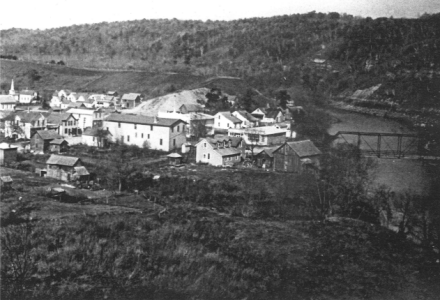
West End of Hammond
York Store is the large white building in the center.
Hammond House Hotel is the building just to the right, with
dormers on the roof. On the right side of the photo you can
see the old bridge, joining the west and east sides of
Hammond.
Contributed by
Sue Buck
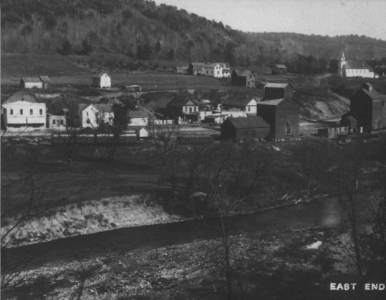
East End of Hammond
Contributed by
Sue Buck
Situated on an easy ford across the Zumbro, on a road
leading from lower down the valley and forking here to the
rich lands eastward, the present site of Hammond easily
became a well known point. This ford was located south of
the present bridge, and north of the mouth of what was then
an excellent trout stream flowing some three miles from the
west, but which is now a dry run. In the first year or so of
settlement the crossing was known as Lyme's Ford, from a
settler named Lyman, who owned woodland on the heights north
of the ford and for a time occupied a cabin there. In 1856
Joseph Hammons settled in the valley about 100 rods south of
what is now the Hammond State Bank. In 1857 Simeon Garlitz
settled on the rise of land east of the present road and
south of the creek. July 3, 1857, he entered the northwest
quarter of the northeast quarter of section 28, township
109, range 13. This land was mortgaged, passed through a
sheriff's sale and finally came into possession of Mr.
Hammons. In time Mr. Hammons built a house on what is now
Main street, about five blocks west of Bridge street. To
this house he moved his family and put in a small stock of
goods, possible to the value of about $300. This store was
continued until a short time before the railroad was built.
Grading on the railroad was started in 1877, and completed
and the rails laid and traffic opened in 1878. About the
time the grading was being done, three shacks were erected
on the present site of the village west of the river.

Hammond Depot
Contributed by
Sue Buck
Bernard Kramer built on the northeast corner of Spring and
Bridge streets. Herman Berg built on lot 2, block 2. Fred
Dosdall built on lot 5, block 2. He engaged for a time in
sawing timber.
In 1878 the first warehouse was erected by Anton Kruger, who
had been farming on section 33, some two miles away. His
financial partner in the warehouse enterprise was Michael
Dosdall, who was farming some four miles south, over the
line in Olmsted County. This warehouse handled the great
quantities of grain which farmers had held over from the
bumper crop of 1877. Edward Noonan was grain buyer and
station agent. It was probably that same year (1878) that
Otto Sass erected a blacksmith shop on lot 4, block 3, north
of the creek, bringing from Lake City the lumber which he
obtained from a machine shed he had bought and torn down. It
was in the year 1878 that a wooden bridge was built on the
site of the present steel bridge.
In 1879 Anton Kruger, the owner of the warehouse, determined
that the village should be located about the warehouse east
of the bridge. With this in view he built a residence on the
north side of the street not far from the warehouse, with
the purpose of establishing a hotel. That same year Wilhelm
Bartz erected and opened a hotel on lot 5, block 1, on the
west side of Bridge street. These and the blacksmith shop
built the previous year constitute the beginning of business
on Bridge street. About this time August Kuehn erected a
house on lot 7, block 3, in the same vicinity. In October,
1879, Nicholas Brucher came here as representative for
Calvin Potter, a Kellogg storekeeper, and opened a store in
the Anton Kruger residence. Mr. Brucher found here the
nucleus of the two business centers which exist.
West of the bridge was the warehouse, in which was also the
railroad office. There was also a small railroad
waiting-room nearby. There was also the Kruger building, in
which he opened his store. The large elevator had been
started. The bridge had been built west of the creek, and
southwest of the river was the blacksmith shop of Otto Sass.
On Bridge street, west of the river, was the hotel of
Wilhelm Bartz, and on Spring street was the home of August
Kuehn. Farther west was the residence of Joseph Hammons. In
the winter of 1879-80 the large elevator, 40 by 80, was
built on the site of the present elevator. The railroad
office was established in the elevator. In the spring of
1880, Nicholas Brucher erected a store on the site of his
present place of business, near where he had operated the
Potter store, and started in the meantime business for
himself. That year a lumber yard was opened not far from the
elevator and warehouse by a Wabasha concern.
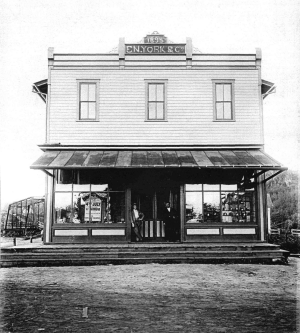
E. N. York Store
Contributed by
Sue Buck

From a newspaper clipping and signed
on the side:
"This is the department I take charge of at the big store ~
N.P. Brucher"
Contributed by
Sue Buck
The Potter Hotel was opened on
the height near the Brucher store. In the old warehouse a
store was operated for a short time in 1880 as a branch of
the Williamson concern at Lake City. Mr. Hammons erected in
1880 a store building on the west side of Bridge street, lot
2, block 4, and rented it to Benjamin Young, who opened a
store in it. A hardware store was opened north of the river
by William Davis, who soon formed a partnership with
Roderick Smith. The building was a vacant store, which had
come into the possession of Fred Kahn, a farmer, and was
moved to the new village of Hammond. Early in 1881 Fred
Dosdall started the building of a hotel on the present site
of the Hammond House, at the west end of the bridge, and
south of the street. Edward N. York opened business, June 2,
1881, in the Hammond building on Bridge street, which had
then been closed about three weeks. It is interesting to
note that the two pioneer merchants are still in business
here. Nicholas Brucher has his store on the site of the one
he opened in 1880. Mr. York continued in business alone for
eleven years, and then had William Kruger for a partner for
two years. Mr. Kruger sold his interest to Adam Funk, and
the E. N. York Mercantile Co. was organized with E. N. York,
Adam Funk and A. R. Haggerty, and the present building
erected. Messrs. York and Funk are in active management, Mr.
Haggerty living in Rochester.
The flood of April 10 and 11, 1888, is an event of much
interest to the older residents. The melting snows of the
preceding "blizzard winter" swelled the Zumbro and spread
out into a great pond. The part of the village west of the
river was completely covered. The York store was flooded
until the water was over four feet above the main floor, and
the goods in the basement and on the main floor were saved
only by the most strenuous work. Fortunately the water in
this part of the town was still. In the eastern part of the
town there was a swift running current which cut through the
elevator but did not carry it away. The old wooden bridge
was washed away and later replaced by a concrete and steel
structure. Pigs and chickens were killed and small buildings
washed away, but considering the extent of the flood the
damage was not as great as might have been expected.
The village of Hammons, named after the original proprietor,
but later changed to Hammond, was surveyed on the west side
of the river, October 31, November 1 and 2, 1877, by H. N.
McDougall for Mr. Hammons. The principal street running
north and south was Bridge street. Parallel to it on the
west were First and Second streets. The east and west
thoroughfares are Main and Spring streets. There was some
uncertainty as to where the bridge was to cross. The present
road to the bridge from Bridge street has no name, having
been established after the village was platted.
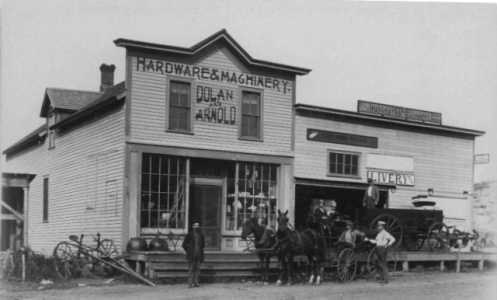
The Dolan and Arnold Hardware Store &
Livery Stable
Contributed by
Sue Buck
Hammond was incorporated in 1900. The first officers were:
President, Nicholas Brucher; trustees, Nicholas Schouweiler,
J. W. Arnold and Albert Fuerstnan; recorder, L. N. Ingalls;
treasurer, M. J. Maldoon; justice of the peace, A. J.
Button; constable (and street commissioner), Herman
Heinbockel. Mr. Brucher served as president also in 1901,
since which time his successors have been as follows: 1902,
Nicholas Schouweiler; 1903 and 1904, Henry Kitzman; 1905,
Adam Funk; 1906 and 1907, Albert Fuerstnan; 1908 and 1909,
Math. Rosch; 1910 and 1911, A. D. Anderson; 1912, Herman
Beyer; 1913, Math. Rosch; 1914, 1915, 1916, 1917 and 1918,
Nicholas Ilgen; 1919, A. D. Anderson; 1920 ... L. N. Ingalls
served three years as recorder, in 1900, 1901 and 1902. His
successors have been as follows: In 1903 and 1904, Nicholas
Brucher; in 1905, S. J. French. In 1907 B. D. Mitchell was
elected, but at once resigned, and Henry Kitzman was
appointed April 2, 1907. Nicholas Schouweiler served in
1908, 1909, 1910 and 1911, and M. M. Anderson in 1912 and
1913. The latter who was appointed, served in 1915, 1916 and
1917. Mr. Hoenk was succeeded in 1918 by G. L. Barberrie.
The village has a complete waterworks system and mains
covering the principal streets. The system was inaugurated
in 1913, with Nathaniel Rosch as president, M. M. Anderson
as recorder, and a council consisting of Rudolph Schacht,
Jr., Nicholas Ilgen and Emil Dickman. The first action was
taken by the board May 23, 1913. A special election was held
June 4, 1913, at which the electors by a vote of 41 to 6
decided favorably on the proposition of issuing bonds to the
amount of $4,000. A 200-foot well was drilled, an 85,000
gallon tank was installed, and a windmill on a 40-foot
galvanized iron tower erected on one of the heights
overlooking the village. An engine was also installed as an
auxiliary to the windmill. Mains were laid along the
principal streets. Certain specifications regarding the
river crossing were not complied with, and it was some time
before the village fathers finally accepted the system. For
some years, however, the river crossing continued to be a
source of trouble and leakage. The village property outside
of the waterworks system consists of a hose house and fire
apparatus, and a combined lock-up and council room.
The fire department had its beginning January 3, 1905, when
the council approved as fire chief, John Dolan, who, with
the chief engineer and ten others, were to constitute the
fire department. After the waterworks were put in, the fire
engine was exchanged for 500 feet of hose. The village has
been fortunate in never having had a serious fire.
Three different times tests have been made of individual
street lamps, but none have yet proven satisfactory.
Negotiations are now under way for the use of a private
plant for public lighting.
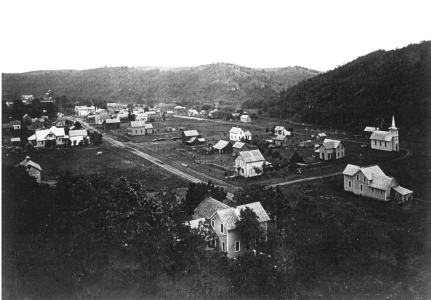
Residential Area
Contributed by
Sue Buck
"Schouweiler's Park," a private
park beautifully located on the banks of the Zumbro, is much
used as a public picnic ground. There is now in the course
of development a combined school and village park which
promises much for the future.
The Hammond Post Office was
established about 1879 in the Wilhelm Bartz Hotel, with Mr.
Bartz as postmaster. In 1880 it was moved to the Hammond
store and Benjamin Young made postmaster. After Mr. Young's
departure, his bondsmen, Joseph Hammons and Samuel Corp,
conducted the office a few months. June 3, 1881, E. N. Corp
was appointed. He kept the office in the same place, and
when he moved his store, moved the office with it. He was
succeeded July 20, 1907, by M. M. Anderson, who moved it to
its present location in the Hammond State Bank building.
The first creamery was started
in 1887 by Anton Kruger and E. N. York. After operating it
four years, they rented it out for an equal length of time,
and then sold it to the present Farmers' Creamery
Association.
The Hammond Building Block Co.
was organized July 27, 1904. The company consists of Adam A.
Funk, Herman Heinbockel, L. N. Ingalls and Rudolph Schacht,
Sr. The concern is engaged in making building and ornamental
blocks, and enjoys quite a trade in this and surrounding
towns.
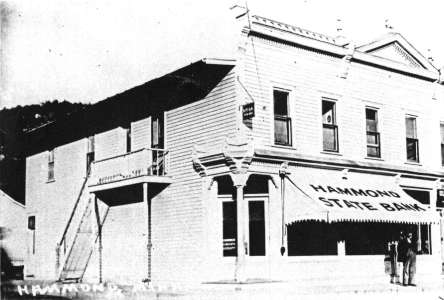
Hammond State Bank
Contributed by
Sue Buck
The Hammond State Bank was
incorporated June 22, 1909, the original stockholders being
W. W. Churchill, Nicholas Brucher, E. N. York, Estella A.
York, Sidney Corp, J. W. Arnold, M. J. Maldoon, G. W. Price,
C. L. Anderson, Nicholas Schouweiler, John McLaughlan,
Herman Miller, John F. Cook, Lorinda M. York, all of
Hammond, Rufus R. Zander, C. A. Hoffman and M. Wanke, of
Jarrett; William Koenig, of Rochester; F. J. McLaughlin, of
Donnelly; C. L. Chamberlain, of Wabasha, and Jacob H. Seim,
of South Troy. The first board of directors was composed of
the above mentioned stockholders with the exception of John
F. Cook, F. G. Colburn and Jacob H. Seim. At the first
regular meeting of the board, held August 3, 1898, the
officers elected were: M. J. Maldoon (president), John
McLaughlin (vice-president), W. W. Churchill, of the First
National Bank of Rochester (cashier), E. N. York, Nicholas
Schouweiler, Sidney Corp, J. W. Arnold, Herman Miller, Rufus
R. Zander and C. A. Hoffman. The original capital stock was
$10,000, and the bank opened for business in the west half
of a building erected for that purpose by Mr. Maldoon. It
has enjoyed a highly prosperous career with a steadily
increasing volume of business, as shown by the following
figures: In 1900 its deposits were $30,253.01; loans and
discounts, $32,776.63; 1905, deposits, $51,850.02; loans and
discounts, $93,423.51; 1915, deposits, $142,876.07; loans
and discounts, $155,796.42; 1919 (report of December 31),
capital stock, $25,000; surplus and undivided profits,
$8,217.93; deposits, $250,435.03; loans and discounts,
$227.922.88. The following list shows the successive changes
in the official staff: Presidents ~ 1898, M. J. Maldoon;
1901, E. N. York; 1902, Nicholas Schouweiler; 1903, Nicholas
Brucher (declined to serve), M. J. Maldoon; 1904, E. N.
York; 1907, M. J. Maldoon; 1909, Nicholas Schouweiler; 1913,
William Koenig; 1914, Nicholas Schouweiler.
Vice-presidents ~ 1898, John M. Loughlin; 1900, E. N. York;
1901, Nicholas Brucher, 1903, Henry Kitzman; 1905, M. J.
Maldoon; 1906, Nicholas Schouweiler; 1908, William Koenig;
1909, John Robinson; 1910, William Koenig; 1913, W. W.
Crawford; 1919, William Koenig.
Cashiers ~ 1898, W. W. Churchill; 1902, Glen W. Mosher;
1903, Nicholas Schouweiler; 1904, Bert D. Mitchell; 1909, E.
N. York; 1919, W. E. York.
Assistant cashiers ~ March 17, 1899, H. A. Haynes; January
1, 1900, Glen W. Mosher; January 12, 1903, Bert D. Mitchell;
January 12, 1904, to January 12, 1909, none; January 12,
1909, Walter E. York; January 12, 1912, Walter E. York and
B. E. Fick; January 12, 1915, Walter E. York and Charles
Timm; January 12, 1919, Otis Preston; September 1, 1919
(clerk), M. M. Anderson.
The officers chosen January 13, 1920, were: Nicholas
Schouweiler (president), William Koenig (vice-president), W.
E. York (cashier), M. M. Anderson (assistant cashier), John
Robinson, E. N. York, W. M. Crawford, Thomas W. Cooke,
Nicholas Schouweiler, William Koenig, L. A. Welke, John E.
Webster and O. H. Olson.
The Farmers' State Bank of
Hammond was organized September 1, 1915, through the efforts
of A. J. Hodge, of the Mazeppa Peoples State Bank, a former
resident of this vicinity, and opened its doors for business
September 10, 1915. Its officers were: John F. Cooke
(president), A. J. Hodge (vice-president), F. A. Hodge
(cashier), A. F. Polson, Nick Ilgen, Edw. Reinke, A. W.
Haggerty, W. P. Pencille, Lynn R. Anderson, and A. D.
Anderson. The bank started business with a capital of
$10,000 and a surplus of $2,000. Its first quarters were in
the Elgin Hardware Store, but the erection of a new building
was at once begun, and was subsequently completed, being
occupied January 1, 1916. The deposits December 3, 1915,
were $27,786.38; loans and discounts, $26,882.00. On
December 31, 1916, the deposits were $86,153.43; loans and
discounts, $83,278.32. On December 31, 1917, the deposits
were $149,640.59; loans and discounts, $135,646.14. On
December 31, 1918, the deposits were $169,074.89; loans and
discounts, $158,859.26. In September, 1919, the capital was
increased to $15,000, and the surplus to $3,000. F. A. Hodge
was sole cashier up to June, 1919, when Arthur Funk was
hired as helper, and the latter became assistant cashier
January 1, 1920. John F. Cooke still remains president. Mr.
Hyde was succeeded as vice-president in 1917 by W. D.
Pencille, and as director by J. M. Meyer. In 1920 F. A.
Hodge succeeded A. F. Polson as director.
St. Clement Church, Hammond, Minn.
~ The first Catholic settlers in the village of Hammond and
vicinity, coming from centers of Christian influence, were
not unmindful of the necessary spiritual things in their new
homes. In the early days of the settlement the first few
Catholic families were favored with occasional visits by the
old and venerable pioneer priest, Father Tissot, of Wabasha,
and his noble successor, Father James Trobec, who held
religious services in the humble log cabins of the faithful.
In the fall of 1879, Father Jacobs took charge of this
station, having been appointed the first resident pastor at
West Albany. In the spring of 1881 the first church was
erected ~ a frame structure 26 by 36 feet, with a sanctuary
12 by 16 feet. The work on the building was done by John
Wagner and Nicholas Nei. Father Boland succeeded Father
Jacobs in 1883, and was followed by Fathers Ryan, Fox, Stolz,
Shels and Schwartz. Under the pastoral administration of
Rev. Fr. Shels, an addition 16 by 26 feet to the main body
of the church was built, with a tower 72 feet in height, and
a gallery in the interior of the church. Rev. Fr. Schwartz
aided in the improvements of the church by frescoing the
interior, excavating the basement, and purchasing two fine
harmonious ringing bells. In November, 1900, Fr. Mueller
took charge of the Mission, and during his incumbency, which
is still in force, various improvements inside and outside
of the church have been made. The first settlers of this
mission are: Math. Funk, Ed. Riley, W. Sauls, Pat Murray,
Edward Kinney and M. McCarthy. What the first pioneers of
this mission have done without thought of recompense will be
a lasting memory forever. The cold hand of death cannot blot
out the record of work they have accomplished as a strong
impression upon the minds of the future generations.
Rev. Francis X. Mueller.
HYDE PARK TOWNSHIP
Hyde Park Township occupies that part of Congressional
Township 109, Range 13, lying north of the Zumbro River. It
is bounded on the north by Gillford, on the east by Oakwood,
and on the south and west by Zumbro Township. The land is
varied. Along the banks of the Zumbro and extending some two
miles north the land is rough and hilly, and was originally
covered with a heavy growth of oak timber.
In the early part of May, 1855, Paris Devitt and Samuel
Parker settled in this district of country now known as Hyde
Park. The next day after their arrival came John Ritter,
Charles Holzman, William McCloud; and it was but a very
short time until George and Seymore Fanning and the Baker
families arrived and took up homesteads. It was the rolling
farm-land, dotted with poplar groves, which attracted these
men, some of whom came from northern Pennsylvania, while
others from Maryland. The close of the summer of 1855 found
almost every quarter-section "claimed," and a log cabin
erected to shield the pioneer from Minnesota's wintry
blasts. The winter of 1855-56 is a notable one in the
history of the country as the "cold winter," and the early
settlers suffered greatly since they were so far from mill
and market, besides their means were very scanty. Many tales
of hardship are related of that "cold winter." When the snow
became so deep and the weather so cold that it was
impossible to get the grain to mill, the old coffee mill was
used, and the words "Flannigan's Mill" bring back to many
old settlers recollections of pioneer life in the winter of
1855-56.
At the time of the government survey the tract of land now
included in the townships of Zumbro and Hyde Park was called
Concord. This name, however, for some reason, did not suit
the people, and at a meeting held May 11, 1858, the name
Troy was chosen. The legislature would not accept this,
however, as another town in the state held the same name, so
it was named Zumbro, after the river which divided it. The
larger part of the population lived on the south side of the
river, and all township elections and meetings were held on
that side. This was a source of trouble to the north side
people, for at the spring and fall elections the river was
swollen so much with the rains that they could not cross but
with a risk of their lives, so a general feeling of
dissatisfaction arose, which culminated in the spring of
1862, in dividing the township by the river, the south part
retaining the name Zumbro. At the first meeting held north
of the river the name Hyde Park was suggested by an
Englishman, so that the township is named after one of the
most famous places in London.
The first settlers of this township coming from centers of
Christian influence, were not unmindful of spiritual things
in their new homes, and with the foundations of their log
cabins they erected altars of prayer and praise. As early as
1856 religious services were held in the cabins of the
farmers, and people old and young came to the meetings. The
first preaching services in the township were held at the
home of John Ritter, and the minister was the pioneer Jas.
McArdell.
In 1856 Wm. Parker opened and stocked the first store in the
township, which he operated until 1856. He was the first
postmaster in the township. John Reller was the first
blacksmith, and he opened the first shop in 1858. Francis
Shaw had the first shoe-shop, which he opened in 1857. The
first birth was that of Effie Woodward, born February 14,
1856. The first marriage was that of Isaac York and Mrs.
Jane Shaw, June 22, 1856.
The first schoolhouse in the
township was built in the summer of 1856, on the northeast
corner of section 3. This schoolhouse was in the district
now numbered 45. The first teacher was Mary Shaw, who
received twelve dollars per month for her services. There
were three families in the district: Shays, Parkers and
Yorks. The first school held in what is now known as
district 46, was taught by Unus Potter in 1857 at a private
house. The next year it was held in a barn owned by r. Peter
Kelley, and the next year a log schoolhouse was built by the
settlers. The first school in district 84 was taught by Lucy
Roberts, probably about 1859.
At the time of the construction of the narrow-gauge railroad
through the township, the question whether the township
should bond itself was voted upon. At the first election the
"bonding" was defeated, but after a few days the decision
was reversed and the people agreed to pay $6,000, giving
seven per cent payable semi-annually. This was a large
amount for so small a township to pay but they have gained
great benefit from the road, since now they have a good
market close at home, whereas, prior to the construction of
the road, the grain and marketing had to be taken by wagon
twenty to twenty-five miles.
Jarretts is a hamlet on the
Midland Division of the Chicago, Milwaukee & St. Paul
Railway. Before there was an inhabitant near the present
site of the hamlet, there was a ford in the Zumbro where the
old settlers in an early day crossed, and since the nearest
dweller was Mr. Jarrett, the place came to be called
"Jarrett's Ford," and when a post-office was established it
received the name of Jarretts. The hamlet really had its
birth in 1878, when the narrow-gauge railroad was built. A
flouring-mill, run by water-power, was built in 1878 by
Kimball & Kitzman. The elevator was put up as a feeder to
the flouring-mill at Mazeppa. Kimball operated the mill for
two years or more, selling to J. L. Owen. It subsequently
passed into the hands of Fred G. Colburn, who has operated
it since, and in 1918 the firm became F. G. Colburn & Son.
F. W. Shaw established a general store about 1878, and
continued in business here many years, or until he went to
Oregon in 1905. His nephew, B. C. Shaw, then conducted the
business for a short time, being succeeded by M. Golden. The
latter sold to the present proprietor, George New. Jarretts
has about 50 inhabitants.
ZUMBRO TOWNSHIP
Zumbro Township embraces all of Township 109, Range 13,
south of the Zumbro River, and all of Township 109, Range
14, south of the Zumbro River and east of the south branch
thereof. The first settlers in this town ~ at that time
Concord ~ were the Baileys, Thomas, George and Andrew, who
came in the early part of 1855, and followed some time in
the summer of 1856 by the Jenkins family, father and two
sons, and a Mr. Baker.
The first school was taught in
the late Isaac Jenkins claim shanty in the summer of 1859,
by Miss Nellie Walker (some say Helen Everet, or Nannie
Walker, but the majority say Nellie Walker), who received
$12 for the term of three months, and boarded herself. This
school, now known as district 49, was organized in 1861, and
the first school after its organization was held in a shanty
built expressly for that purpose by York and Jenkins, and
which was used for that purpose till 1864, when the red
schoolhouse was built on section 31. The first teacher in
the red schoolhouse was Hattie Ruber.
In 1863, a post-office, called South
Troy, was established, but at the end of two years
was discontinued. In 1866, a Mr. John Ralton brought on a
stock of goods and opened a store for the accommodation of
the people in that section of the country.
The records show the first town meeting to have been held
May 11, 1858, when the following officers were elected ~
then known as Troy: George Fanning (chairman), George
Roberts, Edward York, supervisors; John Ritter, clerk; Isaac
Jenkins, assessor; Parish Dewitt, collector; Francis W.
Shaw, A. J. Jenkins, constables; George W. Fanning, Isaac
Jenkins, justices.
The territory now covered by Zumbro, Mazeppa and Hyde Park
is just equal to two full townships and was originally known
as Mazeppa and Concord. Concord was the name of the election
precinct, in which it was situated at the time of the
government survey. Afterward, in May, 1858, at a town
meeting, the name of Troy was adopted by a vote of the
people, by which name it was known till 1861. There being
another town of the same name in the state, the legislature
declined to endorse the action of the town meeting, and
consequently it became necessary to call another meeting;
this time to consider the propriety of dividing the town as
well as adopting another name.
The river Zumbro entered the town of Troy from the
northwest, in section 6, a quarter of a mile east of the
town-line, and flowed in a southeasterly direction till it
reached a point one mile south of the center of the town,
where it turned and followed a northeasterly course, and
finally leaving the town about on the line of sections 13
and 24, it being the center of the north and south line.
This river rendered it so inconvenient for the people to
meet, and especially so in the spring, that it was finally
decided (the consent of the county commissioners having been
obtained) at a town meeting held March 19, 1861, to divide
the town, the Zumbro forming the boundary, and also to call
the new town south of the river, Zumbro. Soon afterwards,
all that portion of Mazeppa south of the Zumbro River and
east of the sough branch thereof was added to the new town
of Zumbro.
The hamlets in Zumbro Township are South Trip (sic - must be
South Troy) and Bremen Corners. The village of Hammond lies
partly in Zumbro and partly in Hyde Park.
|
This history originally located at
http://www.rootsweb.ancestry.com/~mnwabbio/3ch14.htm
Original page was difficult to read due to fixed width background used |
|





